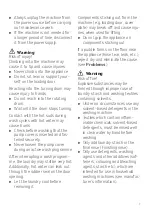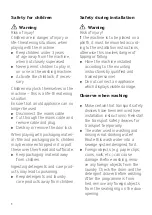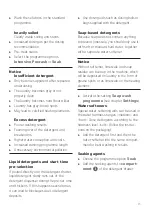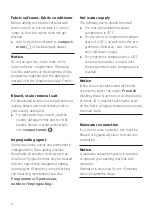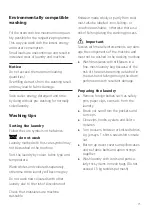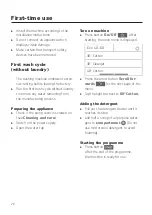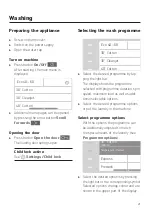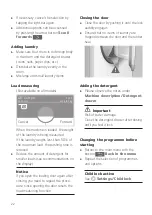
15
Environmentally compatible
washing
Fill the drum with the maximum load quan-
tity possible for the respective programme.
This way you wash with the lowest energy
and water consumption.
Small loads are uneconomical and result in
increased wear of laundry and machine.
Notice
Do not exceed the maximum loading
quantities!
Over filling detracts from the washing result
and may lead to fabric damage.
Save water, energy, detergent and time
by doing without pre-washing for normally
soiled laundry.
Washing tips
Sorting the laundry
Follow the care symbols in the fabrics.
do not wash
Laundry marked with this care symbol may
not be washed in the machine.
Sort the laundry by colour, fabric type and
temperature.
Wash whites and coloureds separately,
otherwise white laundry will become grey.
Do not wash new coloureds with other
laundry due to the risk of discoloration!
Check that brassieres are machine
washable.
Knitwear made wholly or partly from wool
must also be labelled «non-felting» or
«machine washable», otherwise there is a
risk of felting during the washing process.
Important
Textiles with metal reinforcements can dam-
age the components of the machine and
must not be washed in the washing machine.
►
Wash brassieres with stiffeners in a
fine-mesh laundry bag because of the
risk of the wires becoming detached in
the wash and falling through the drum
perforations with resultant damage.
Preparing the laundry
►
Remove foreign bodies such as safety
pins, paper clips, coins etc from the
laundry.
►
Brush out sand from the pockets and
turn-ups.
►
Close zips, hooks, eyelets and Velcro
closures.
►
Turn trousers, knitwear or knitted fabrics,
e.g. jerseys, T-shirts, sweatshirts inside
out.
►
Button up duvet covers and pillowcases
and tie fabric belts and apron strings
together.
►
Wash laundry with cords and particu-
larly tricky items in mesh bags (Do not
exceed 1.5 kg textiles per mesh).
Summary of Contents for Priate household
Page 59: ...59...







